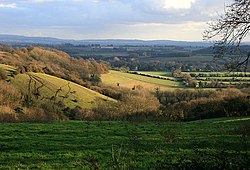Holybourne
| Holybourne | |
| Hampshire | |
|---|---|
 Holybourne from Holybourne Down | |
| Location | |
| Grid reference: | SU735409 |
| Location: | 51°9’47"N, 0°56’58"W |
| Data | |
| Post town: | Alton |
| Postcode: | GU34 |
| Local Government | |
| Council: | East Hampshire |
| Parliamentary constituency: |
East Hampshire |
Holybourne is a village in Hampshire, a mile and a half north-east of the centre of Alton in the east of the county. It has become effectively a contiguous, north-eastern suburb of Alton.
The village has a population of around 1,500. The local pub is The White Hart.
Contents
History
Holybourne is recorded in the Domesday Book of 1086 as Haliborne and appears in 1418 as Halybourn.[1]
The name is thought to be derived from the Old English Haligburna which means holy stream, referring to the small stream whose spring is near Holybourne Church whence it runs through the village.[2]
The author Elizabeth Gaskell (1810–1865) bought a house in Holybourne in 1865. She died suddenly when visiting the house on 12 November 1865.
Being located close to the former RAF Lasham airfield gliders are often spotted in the sky.
RAF Odiham is home to the British Chinooks and has a flight path over the village at a low level allowing excellent views of the aircraft.
Cuckoo's corner, near the end of the village, has the remains of a Roman road and often finds are found in surrounding fields and cricket pitches.
There is one pub in the village, The White Hart[3] along with a small shop with a post office counter.
Complins Brewery
In the nineteenth century, a brewery was established in Holybourne by Walter Complin, who died in 1890. By the start of the 20th century, it was run by John Fowler Complin.[4] The site is now occupied by a residential area called Complins.
Holybourne Oil Terminal
In 1984, planning permission was granted for the Holybourne Oil Terminal, served by the railway, to be the trans-shipment point for production from the Humbly Grove oil field, Lasham, delivery of the oil to be by pipeline. In 1989, further permission was granted to deliver a limited amount of crude oil by road tanker. The freight trains serving Holybourne arrive at Holybourne Freight railway station.
Church of the Holy Rood
The Church of the Holy Rood in Holybourne has foundations dating from the 12th century,[5] and the nave, west end and lower part of the tower appear to date from this time. The chancel was added later, completing the building by the 13th century. However, two centuries later the floor of the building was raised, possibly because of nearby springs. The north aisle was replaced in 1879.
In autumn 2009, eight new bells manufactured at the Whitechapel Bell Foundry were installed in the church by Whites Bellhangers, of Appleton, Oxon, who cleaned up the existing three bells and re-hung them on a new bell frame installed higher up in the steeple and connected them back to the clock to continue their chiming role.
The new eight bells are in the key of B, and the heaviest (Bell No 8) weighs 6 cwt 3 qtrs 16 lb. They are inscribed and dedicated as follows:
- No 1 Bell: Jane Austen, writer, 1775–1817
- No 2 Bell: Elizabeth Gaskell, writer, 1810–1865
- No 3 Bell: William Curtis, botanist, 1746–1799
- No 4 Bell: Alfred Munnings, painter, 1878–1959 (the famous equestrian artist, who resided at The White Hart, Holybourne).
- No 5 Bell: Edmund Spenser, poet, 1552–1599
- No 6 Bell: Edward Thomas (poet)|Edward Thomas, poet, 1878–1917
- No 7 Bell: Izaak Walton, angler & biographer, 1593–1683
- No 8 Bell: Rev. Gilbert White, curate & naturalist, 1720–1793
On Sunday, 11 October 2009, there was a Service of Consecration of the eight new bells. On Sunday, 15 November 2009, there was a Service of Dedication by Michael Harley, the Archdeacon of Winchester.
See also
- Holybourne Hill, one Hampshire's highest hills nearby
Outside links
| ("Wikimedia Commons" has material about Holybourne) |
References
- ↑ Plea Rolls of the court of Common Pleas; National Archives; CP 40/557 second entry. Defendant John Pouke lived there
- ↑ Coates, Richard (1989). Place Names of Hampshire. Batsford. ISBN 0-7134-5625-6. http://www.envf.port.ac.uk/hantsgaz/hantsgaz/hgazsrcs.htm.
- ↑ websites4pubs.co.uk. "The White Hart Pub - Dining & Rooms Alton, Hampshire" (in en-GB). https://www.whitehartholybourne.com/.
- ↑ Roger Eldridge (14 December 2004). "The Holybourne Village Magazine". http://www.holybourne.com/news/mag%200704.pdf.
- ↑ John Owen Smith. "Holybourne: Church of the Holy Rood". List of Churches in the area covered by East Hampshire District. http://www.johnowensmith.co.uk/churches/holyboui.htm.
- Anon Church of the Holy Rood, Holybourne July 2011 (available from the church)
